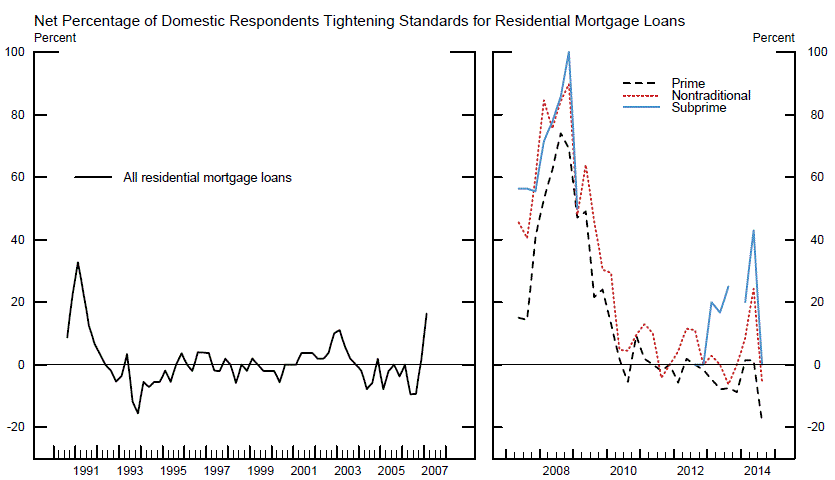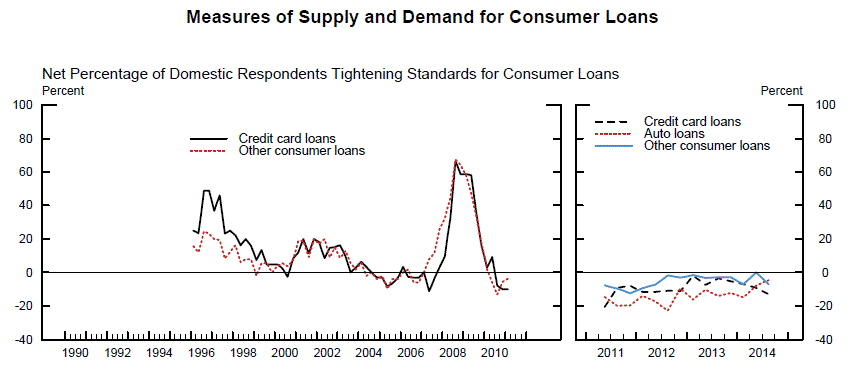Blog

Large Banks Report Lower QM Effects than Other Banks
The Federal Reserve’s July Senior Loan OfficerrnOpinion Survey on Bank Lending Practices showed a continued easing of lendingrnstandards and terms for many types of loan categories amid a broad-based pickuprnin loan demand. Although many banksrnreported having eased standards for prime residential real estate loans,rnrespondents generally indicated little change in standards and terms for otherrntypes of loans to households. </p
Seventy-one banks, almost evenly divided betweenrnlarge banks and “other” banks, responded to most questions about prime residentialrnlending While 20 percent said theirrnlending in that category had remained essentially unchanged over the past threernmonths, 24 percent (mostly large banks) said they had eased their requirementsrnsomewhat. One large bank and three otherrnbanks (5.6 percent of the total) noted some degree of tightening for thesernloans. </p
Only 36 banks reported underwriting nontraditionalrnresidential loans and 78 percent of those reported little change in theirrnstandards while 14 percent reported some easing and 8.3 percent some tightening. Only four banks reported doing any subprimernlending.</p
 </p
</p
Demand for purchase prime mortgages was reported tornbe about the same as three months earlier by 41 percent of respondents andrnmoderately stronger by 50 percent. Amongrnthose banks responding about non-traditional mortgages 80 percent reportedrndemand largely unchanged and 17.1 percent noted a moderate growth.</p
 </p
</p
Among the 71 banks answering questions regardingrnhome equity lines of credit 87 percent said their underwriting criteria wasrnbasically unchanged from the April survey. rnDemand for these loans was reported as moderately stronger by 31 percentrnand unchanged by 60 percent.</p
The July survey included a set of special questions on the effects on thernapproval rates for home-purchase loans of the Ability-to-Repay and QualifiedrnMortgage Standards under the Truth in Lending Act (the ATR/QM rule), which camerninto effect early this year. The majority of banks (62.9rnpercent) reported that the new rule has had no effect on the approval rate ofrnprime conforming mortgages, in part because those loans qualify for a safernharbor under the exemption for loans that meet the underwriting criteria of therngovernment-sponsored housing enterprises (GSEs). Most of the remainingrnrespondents said that the approval rate is somewhat lower than it wouldrnotherwise be. </p
“Other” banks, however were much more likely to report an effect from thernnew rules than larger banks. While 78rnpercent of large banks reported little change in loan approvals, only 47rnpercent of others said this and another 47 percent reported a lower rate ofrnapproval. In addition, among the banksrnreporting that the rules had no effect on their approval rates, about halfrnindicated that lending policies would have been tighter without the safe harborrnfor mortgages that pass the GSEs’ automated underwriting models</p
In contrast, about half of the respondents indicated that the ATR/QM rulernhas reduced approval rates on applications for prime jumbo home-purchase loansrnand nontraditional mortgages. Again thernresponses reporting negative consequences from the rules were skewed toward “other”rnbanks.</p
Among the institutions indicating lower approval rates for such loans, mostrnreported that each of the following provisions were important reasons for thernlower approval rates: the ATR provisions that require mortgage originators tornevaluate income and to assess credit history, assets, and debt payments; andrnthe QM provision that caps the borrower’s back-end debt-to-income ratio at 43rnpercent. Finally, more than half of the 36 respondents that originaternnontraditional mortgages also indicated lower approval rates on nontraditionalrnhome-purchase loans due to the ATR/QM rule. </p
Another set of special questions in the July survey asked respondents torndescribe current levels of lending standards relative to the midpoint of the rangernover which their bank’s standards had varied between 2005 and the present. With respect to the six types of residentialrnreal estate loans included in the survey (prime conforming mortgages, mortgagesrnguaranteed by the Federal Housing Administration or the U.S. Department ofrnVeterans Affairs, prime jumbo mortgages, subprime mortgages, nontraditionalrnmortgages, and HELOCs) standards were reported to be at least somewhat tighterrnthan the midpoints of the ranges that those standards have occupied since 2005.rnHowever, these results still indicate a net easing of credit conditions for thernloans from the even tighter levels reported in the July 2013 survey.
All Content Copyright © 2003 – 2009 Brown House Media, Inc. All Rights Reserved.nReproduction in any form without permission of MortgageNewsDaily.com is prohibited.
Latest Articles
By John Gittelsohn August 24, 2020, 4:00 AM PDT Some of the largest real estate investors are walking away from Read More...
Late-Stage Delinquencies are SurgingAug 21 2020, 11:59AM Like the report from Black Knight earlier today, the second quarter National Delinquency Survey from the Read More...
Published by the Federal Reserve Bank of San FranciscoIt was recently published by the Federal Reserve Bank of San Francisco, which is about as official as you can Read More...

Comments
Leave a Comment